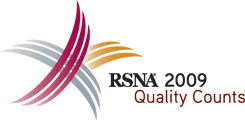
Abstract Archives of the RSNA, 2009
SSE15-02
Comparison between MRI Contrast-Enhancing Tissue Volume and Reported Pathological Tissue Viability in Treated Soft Tissue Sarcomas
Scientific Papers
Presented on November 30, 2009
Presented as part of SSE15: Musculoskeletal (Quantitative Imaging)
Anand K.H. Singh MD, Presenter: Nothing to Disclose
David C. Harmon MD, Abstract Co-Author: Nothing to Disclose
Daniel Ira Rosenthal MD, Abstract Co-Author: Nothing to Disclose
Gordon J. Harris PhD, Abstract Co-Author: Medical Advisory Board, Fovia, Inc
Hiroyuki Yoshida PhD, Abstract Co-Author: Patent holder, Hologic, Inc
Patent holder, Median Technologies
To compare the enhancing tumor volume percentage obtained by segmentation on MRI dataset to the percentage tissue viability on pathology in patients treated for soft tissue sarcomas.
In this on-going retrospective study, post-gadolinium T1 weighted fat saturated (FS) sequence from MRI data sets of 20 patients treated for pathologically proven soft tissue sarcomas were retrieved from the database. MRI was obtained within 1-15 days prior to surgical excision. The images were transferred to a 3D workstation where semi-automated mapping for estimation of enhancing portion and total tumor volume was performed using an image segmentation on post contrast T1W sequence by a radiologist. The percentage of enhancing portion of total tumor was then compared to pathology post-excision which reported percentage tissue viability.Bland-Altman, paired t-test, and correlation analyses were performed for comparing the results of both the two methods.
In all the cases, the enhancing tumor volume percentage derived from MRI volumetry was within range of 95% confidence limits of agreement with pathology and 1.96 standard deviation (SD) [81.9 to -105.0]. There were no outliers and the two-tailed paired t-test showed that there was no statistically significant difference between the values obtained by the two measurements (P=0.9481). There was also a high correlation (r=0.97; P<0.0001) between the volumetry and pathology measurements. These results indicate that the difference between the volumetry and pathology was clinically unimportant and thus can be used interchangeably.
Selective mapping and quantification of MR contrast enhancing portions in soft tissue sarcoma shows similarity to percentage of tissue viability reported on pathology report post-tumor excision. MRI volumetry may be promising in providing an objective measurement for assessing tissue viability.
The similarity between MR contrast enhancing portions of soft tissue sarcoms and pathology tissue viability is more objective which can guide the oncologist/radiation-therapist in treatment planning.
Singh, A,
Harmon, D,
Rosenthal, D,
Harris, G,
Yoshida, H,
Comparison between MRI Contrast-Enhancing Tissue Volume and Reported Pathological Tissue Viability in Treated Soft Tissue Sarcomas. Radiological Society of North America 2009 Scientific Assembly and Annual Meeting, November 29 - December 4, 2009 ,Chicago IL.
http://archive.rsna.org/2009/8006900.html

